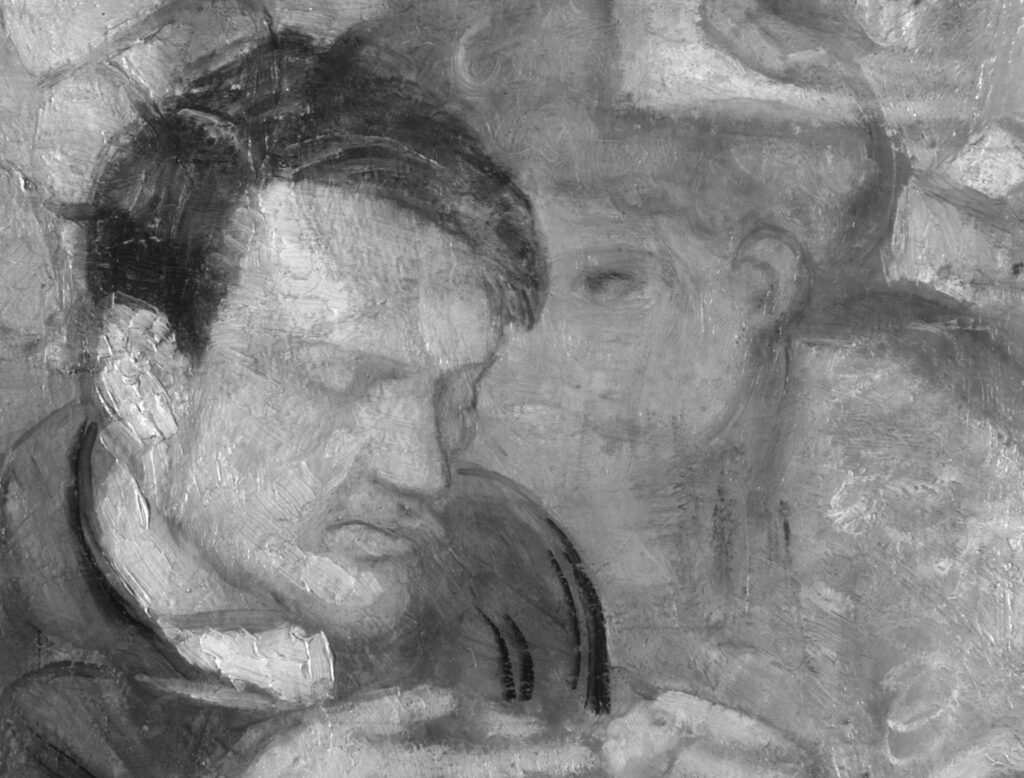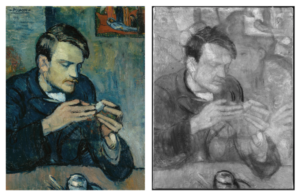The world of art has long been a realm of hidden stories, lost masterpieces, and enigmatic secrets waiting to be uncovered. The recent revelation by a team of art conservators at the Courtauld Institute of Art in London has once again highlighted the layered complexity of artistic creation. Using advanced imaging technology, experts have discovered a concealed portrait beneath the surface of Pablo Picasso’s Portrait of Mateu Fernández de Soto, a significant work from his early Blue Period (1901–1904).
This discovery not only sheds new light on Picasso’s evolving artistic techniques but also deepens our understanding of the financial and material constraints artists faced during that time. The hidden portrait—a depiction of a yet unidentified woman—provides valuable insight into Picasso’s working process, hinting at his personal struggles and artistic explorations.
The use of cutting-edge imaging technology, including x-ray and infrared scans, has allowed researchers to peel back the layers of paint and reveal an unseen dimension of Picasso’s work. As art conservation techniques continue to evolve, discoveries like this reinforce the importance of technology in preserving and reinterpreting historical masterpieces.
In this in-depth exploration, we will discuss the significance of Picasso’s Blue Period, the importance of Portrait of Mateu Fernández de Soto, the implications of this hidden portrait, and the role of technological advancements in modern art research.
The Blue Period: A Time of Transformation
Pablo Picasso’s Blue Period (1901–1904) represents one of the most emotionally profound phases in his artistic career. The dominant use of blue hues in his paintings during this time was reflective of his melancholic state, deeply influenced by personal tragedies, including the suicide of his close friend Carlos Casagemas in 1901. This period also marked Picasso’s early artistic maturity, where he moved away from the influence of traditional academic painting and began to develop a unique and introspective style.
The paintings from this period often depict themes of sorrow, despair, and loneliness, featuring subjects such as beggars, blind figures, and those living on the fringes of society. The limited color palette and the elongated, ghostly forms of his figures emphasize the emotional depth of his work.
Portrait of Mateu Fernández de Soto: A Significant Work
Painted in 1901, Portrait of Mateu Fernández de Soto is among the earliest works of Picasso’s Blue Period. The subject of the painting, Mateu Fernández de Soto, was a sculptor and friend of Picasso, placing this work within the artist’s intimate social circle. The portrait captures a contemplative and subdued expression, characteristic of the melancholic themes that dominated Picasso’s work at the time.
The discovery of a hidden portrait beneath this painting suggests that Picasso reused his canvas—a common practice among artists facing financial difficulties. This revelation is particularly significant because it offers a glimpse into his artistic process, showing that he may have initially intended to paint something entirely different before deciding to repurpose the canvas for a new composition.
The Hidden Portrait: A Mystery Woman Emerges
The Discovery Through Advanced Imaging
The concealed portrait beneath Portrait of Mateu Fernández de Soto was uncovered using state-of-the-art imaging technology, including x-ray fluorescence and infrared reflectography. These techniques allow conservators to penetrate through layers of paint without damaging the artwork, revealing earlier compositions and modifications.
Infrared imaging exposed the faint outline of a woman’s face beneath the final layer of paint. Her identity remains unknown, but her presence hints at Picasso’s evolving creative process and possibly an abandoned concept or commission.
Who Was the Hidden Woman?
While art historians have yet to determine the identity of the woman in the hidden portrait, her presence raises intriguing questions. Was she someone significant in Picasso’s life? Could she have been a model or muse that he later decided to replace with a portrait of his friend?
Picasso was known for painting the women in his life, whether they were lovers, friends, or patrons. The possibility that this mysterious woman had personal importance to the artist adds another layer of intrigue to the discovery. Further research and comparisons with other portraits from this period may provide clues to her identity.
The Role of Technology in Unveiling Art’s Hidden Secrets
Advances in Art Conservation and Analysis
The discovery of the hidden portrait within Portrait of Mateu Fernández de Soto exemplifies the power of modern technology in art research. Techniques such as:
• X-ray fluorescence (XRF): Identifies the chemical composition of pigments, revealing underlying layers.
• Infrared reflectography (IRR): Detects carbon-based drawings and underpaintings invisible to the naked eye.
• Hyperspectral imaging: Captures a range of wavelengths to reconstruct earlier stages of a painting.
These tools allow art historians and conservators to explore an artist’s working methods, uncovering previously unknown details about a painting’s history.
Similar Discoveries in Picasso’s Work
This is not the first time hidden compositions have been found beneath Picasso’s paintings. Several of his Blue and Rose Period works have revealed concealed images, demonstrating his tendency to repurpose canvases. For example:
• “The Old Guitarist” (1903–1904): X-ray imaging revealed an earlier painting of a woman beneath the surface.
• “La Miséreuse accroupie” (1902): A hidden landscape was discovered beneath the composition.
• “Woman Ironing” (1904): Another concealed painting was found under this piece.
These discoveries indicate that Picasso frequently reused canvases, either due to financial hardship or shifts in artistic direction.
The Artistic and Historical Significance of the Discovery
The hidden portrait beneath Portrait of Mateu Fernández de Soto provides a rare window into Picasso’s evolving artistic decisions. It suggests that he experimented with multiple ideas before settling on a final composition, reflecting his continuous search for artistic expression.
By studying these hidden layers, researchers gain insights into the progression of his work—how he constructed his figures, altered compositions, and engaged with his subjects. These discoveries contribute to a more nuanced understanding of Picasso’s Blue Period and its broader significance in art history.
The Broader Impression on Art History
The revelation of the concealed portrait also reinforces the notion that masterpieces often carry unseen histories. Many famous paintings may still hide abandoned ideas, early drafts, or entirely different subjects beneath their final versions.
As imaging technology continues to advance, more hidden artworks will likely be uncovered, deepening our understanding of the artistic process and the material conditions under which historical artists worked. This enhances not only our appreciation of well-known masterpieces but also our knowledge of how art evolved over time.
Impression
The discovery of a hidden portrait beneath Picasso’s Portrait of Mateu Fernández de Soto is a testament to the power of modern technology in uncovering art’s long-buried secrets. This finding provides valuable insights into Picasso’s working methods, financial struggles, and creative decision-making during his formative Blue Period.
No comments yet.









